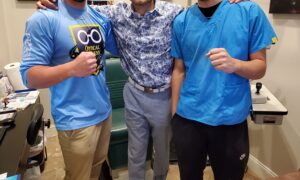By Keshav Bhat, OD

May 20, 2020
The face covering requirement in many states, and the guideline that health-care practitioners wear masks when providing services, means the way we relate to our patients will change. With most of their face covered, we have to pay special attention to determine how they are reacting to our words and exam.
We have often heard that the eyes are the windows to the world – this applies to us optometrists as we examine these “windows.”
Despite a subtle flattening of the curve in the number of COVID-19 cases, the Centers for Disease Control has recommended that we wear face masks as we gear up to open our practices. We have become accustomed to seeing people’s faces and noticing how they feel based on the expressions made with their mouths–smiling, frowning, gritting their teeth. With so much of their faces now covered, how do we read their reactions to us?
Look Closely at Their Eyes for More than Eye Health & Refraction
The nose, mouth, cheeks and jaws are covered, but we can still see emotions in our patients’ eyes. This applies to how patients perceive you and your words.
You can still get a sense of emotions by focusing on the eyes. Here is a primer to reading patient emotions based on their eyes:
Happiness
Corners of the eyes crinkle.
Sadness
The eyes look heavy, droopy.
Anger
The eyebrows straighten and the eyes tend to glare.
Confusion
The skin between the two eyebrows can wrinkle briefly.
Note Your Patient’s Body Language
There’s a connection between your emotions and body language.
Happiness
Body language that’s light, airy, almost defying gravity. The patient will give a sense of energy in their movements, as if their movements require little effort.
Anger
Tightness in the hands, shoulders, arms and legs.
Fear and Anxiety
Look for stillness or stiff gestures. Maybe even knuckle cracking.
To get a better sense of how body language correlates to emotions, watch a movie with a renowned actor like Meryl Streep or Robert DeNiro, and make mental notes of the body gestures that were used to portray emotions like anger and fear.
We Need to Gauge Their Feelings to Ensure We Are Meeting Their Needs
As all health-care professionals should, we need to recognize that patients come in with a certain sense of anxiety so that our reassurance goes a long way. Whether it is addressing a change in eyeglasses or contact lens prescription, explaining what astigmatism is, a suspicion of glaucoma, or cost of eyewear, what we say and how we say it makes an impression on the patient both with respect to us as providers and to our practices.
Other Articles to Explore
The introduction of electronic health records also poses unique challenges – as many providers and staff are accustomed to asking questions of the patient while looking at the monitor. We recently had an elderly gentleman who had forgotten his hearing aids and did not inform us; the technician continued to ask questions while typing away, and the patient was sitting silently. Only after repeated questioning it occurred to us that he was completely unaware that we were talking to him!
Having a team member learn sign language during this downtown may not be a bad idea. Online courses are available for as low a fee as $9 or even free.
With our exams scheduled at longer intervals to avoid too many patients in the office at one time, take the time in the exam room to fully explain your findings and recommendations.
The COVID-19 crisis, and the resulting lock-down order, has been trying for all of us. Be sure to patiently explain all of your exam findings and eyewear prescriptions, noting your patients’ feelings–and being responsive to those emotions.
 Keshav Bhat, OD, is the owner of Union Family Eye Associates in Charlotte, N.C. To contact him: drbhat@unionfamilyeye.com
Keshav Bhat, OD, is the owner of Union Family Eye Associates in Charlotte, N.C. To contact him: drbhat@unionfamilyeye.com



























